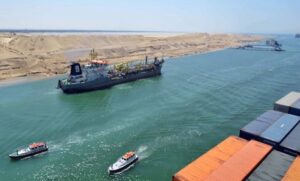The Suez Canal Zone & The Canal Cities
The Suez Canal severs Africa from Asia and links The Mediterranean with the Red Sea. Watching super-tankers gliding through the desert as they ply the narrow channel is a bizarre spectacle.
A hotly contested triumph of modern engineering, the canal opened in 1869 after 10 years of construction and remains one of the world’s busiest shipping lanes.
The Suez Canal Corridor area is a mega project in Egypt that was launched on 5 August 2014 by president Abdel fattah El-Sisi. The project’s aim is to increase the role of the Suez Canal region in international trading and to develop the three canal cities: Suez , Ismailia, and Port said.
The project involves building a new city (New Ismailia City), an industrial zone, fish farms, completing the technology valley, building seven new tunnels between Sinai and Ismailia and Port Said, improving five existing ports, and digging a new canal parallel to the Suez Canal. The new canal will increase the canal capacity by allowing ships to sail into both directions at the same time for a greater proportion of the canal. The project will transfer the canal cities into an important trading centre globally. It will also build new centres on the Suez Canal for logistic and ship services. This project was completed in January 2016.
The project is also known as “The Great Egyptian Dream” because it will help the economy of Egypt after many years of unrest and corruption.
The canal is an artificial sea-level waterway running north to south, stretching from Port Said and the Mediterranean Sea to Suez and the Red Sea.
The Suez Canal is one of the most important waterways in the world. It changed the face of maritime world trade. It provides the shortest maritime route between Europe and the lands lying around the Indian and Western Pacific Oceans. It allows ships to travel between Europe and Eastern Asia without navigating around Africa. It is one of the world’s most heavily used shipping lanes.
The earliest effort to connect the Red Sea and Mediterranean was directed by King Senusret III, in the 12th dynasty (1878-1843 BC).
The canal is now 164 km (102.11 mi) long, 24 m (79 ft) deep and 205 meters (673 ft) wide. It is wide enough to allow ships having a maximum draft of 16 meters (53 feet).
The New Suez Canal is 72 km (45 mi) long, including 35 km (22 mi) of dry digging, and 37 km (23 mi) of “expansion and deep digging” to provide a second shipping lane in the existing 164-kilometre-long (102 mi) canal, allowing for separated passing of ships in opposite directions. It also includes the deepening and expansion of a 37-kilometre-long (23 mi) section of the existing canal
The Suez Canal has no locks, so seawater flows freely through it. It is owned and maintained by the Suez Canal Authority (SCA) of Egypt.
You can cross the Canal via several ways: by the passenger ferry, El Ferdan railway Bridge, El Qantara Bridge, Ahmed Hammdi Tunnel and The Suez Canal Bridge all of which run almost non-stop during the day.
What to see:
You can visit the Suez Canal by visiting one of the 3 Canal Zone Cities, which are Ismailia, Port Said, and Suez.
Ismailia City:
Ismalia City is located approximately half way between Port said in the North and Suez in the south. The canal widens at that point to include Lake Timsah, and one of the Bitter lakes, linked by the canal. The city has a population of approximately 750,000 inhabitants.
Ismailia was founded in 1863, during the construction of the Suez canal, by Khedive Ismail, after whom the city is named. The head office of the Suez canal Authority is located in Ismailia at the shore of Lake Timsah.
It still has a large number of buildings dating from British and French involvement with the Canal. Most of these buildings are still used by canal employees and officials.
What to see:
Ismailia Museum was established in 1932, with more than 4000 objects from Pharaonic, Greco-Roman and Islamic eras. They are housed in this small but interesting museum on the eastern edge of town. The collection includes statues, scarabs, stelae and records of the first canal, built between the Bitter Lakes and Bubastis by the Persian ruler Darius. The highlight of the museum is a 4th-century-AD mosaic depicting characters from Greek and Roman mythology.
The Memorial of 6 October, 1973 Victory was inaugurated on 5 th October 1992 on the East bank of the Suez Canal and was modelled after a bayonet.
The Memorial of the Unknown Soldiers overlooks the Suez Canal. It symbolizes the victims of World War, and is composed of 2 obelisks behind 2 girls carrying on olive branch and a dove of peace.
Tabet Al-Shagara was the headquarters of the Israeli enemy leadership during the October war.
Once the residence of the one-time French consul to Egypt, De Lesseps, the house currently serves as a private guest house for visitors of the Suez Canal Authority, but closed to the public.
Lake Timsah is known for its calm water on which many beaches are located and where there is opportunity for many water sports.
The Bitter Lakes are impressive lakes where the governorate has encouraged tourism by establishing new tourist villages.
The Suez Canal Bridge is a road bridge crossing the Suez canal. The bridge links the continents of Africa and Asia.
Port Said City:
One unexpected, but very interesting, monument links New York and Port Said together. Originally, the statue of Liberty was to be placed not in New York but at Port Said. The Statue of Liberty was inspired by the huge statues at Abu Simbel. Auguste Bartholdi, the sculptor of the statue, designed the American Lady of Liberty as ‘Egypt carrying the light of Asia’. However, the Khedive Ismail decided that the project was too expensive, so the ‘Light of Asia’ was sent to the US instead, where she became the Statue of Liberty.
Port Said is on the coast where the Suez Canal meets the Mediterranean; it is largely built on land reclaimed from Lake
Manzila.
The origin of Port Said is a working camp founded in 1859 by Said Pasha to house men working on the Suez Canal. By the late 19th century, it was an important port where all the major maritime powers had consulates.
Port Said has acted as a global city since its establishment and flourished particularly during the 19th and the first half of the 20th century when it was inhabited by various nationalities and religions. Most of them were from Mediterranean countries.
The city was damaged during the Suez Crisis, and again during the wars of 1967 and 1973, but the city has largely been rebuilt and today is a pleasant city, with a population of around 600,000 people. It is also considered a summer resort by Egyptians and the beach is lined with vacation bungalows.
Across the Canal from Port Said is Port Fuad, which is really only a bedroom community to Port Said. It is a very pleasant place to take a stroll among the gardens and sprawling residences located there.
What to see:
The Martyrs Memorial was constructed to commemorate the martyrs of Port Said in the battles of the Tripartite Aggression during the Suez Crisis.
The Lighthouse of Port Said is the only original building still standing in Port Said, and the first building in the world built from reinforced concrete. Considered a unique example for the evolution of architecture during the nineteenth century in the city, it was designed by Francois Coignet at the request of the Khedive of Egypt and Sudan. Construction was completed in 1869, one week prior to the inauguration of the Suez Canal, to guide the ships passing in the canal. It is an octagonal tower that stands at 56 m (184 ft.) high.
The Military Museum was inaugurated in 1964. This little museum is worth a peek for its information on the canal, and also some rather curious exhibits (complete with toy soldiers) narrating the story of the Egyptian resistance in Port Said for the Tripartite Aggression during the Suez Crisis in 1956, and the wars of 1967 and 1973 with Israel. In the museum gardens you can view a few captured US tanks, as well as an odd collection of UXOs (unexploded ordnance).
The National Museum has about 9000 artefacts that narrate the story of Port Said and Egypt. It was opened in 1987; it contains exhibits on the 1st floor covering prehistory and the Pharaonic Period, including several mummies and sarcophagi along with various statues and other artefacts. On the next floor is Islamic and Coptic material, including textiles, manuscripts and coins, as well as artefacts from the Khedival family, It is currently closed for restorations.
Suez Canal House was built in time for the inauguration of the canal in 1869. As it’s currently fenced off (it’s not open to the public), the best way to get a good look at the building’s famous façade is by hopping on the free ferry to Port Fuad.
The heart of Port Said is located along the edge of the canal; the Waterfront neighbourhood seems infused with a ‘back in the good old days’ atmosphere, the streets lined with late 19th-century and early 20th-century buildings complete with rickety wooden balconies, louvred doors and high veranda’s. The raised board walk all the way along Palestine Street affords sweeping views over the canal.
Around the streets, there are wonderfully odd colonial remnants, such as the old canal shipping agency building, the once highly fashionable Simon Arzt department store and the archway entrances still announcing the Bible Society building. There is also an impressive collection of churches, including the Coptic Orthodox Church of St Bishoi, the Church of the Virgin and the Franciscan compound.
The Museum of Modern Art is both a Modern and Contemporary art museum. The town of Port Said has an international history of being a cultural crossroads and cosmopolitan community, located at the confluence of the Suez Canal and Mediterranean Sea, on the easternmost edge of the Nile Delta region. It is opened in 1995 and displays a collection of contemporary paintings, graphics, drawings, and ceramics created by Egyptian artists.
Ashtum El Gamil and Tanees Island National Park lies 7 km (4.4 miles) West of Port Said. The area is a prime spot for bird watching.
Suez City:
Perhaps most well known for the Suez Canal, the seaport city of Suez is quite an important metropolis in North-Eastern Egypt. It is located on the Gulf of Suez (a branch of the Red Sea), near the southern end of the Suez Canal, and has an approximate population of 500,000 people.
This city gives an excellent view of Sinai and the Red Sea. Being a seaport, its location makes it a good stopping point for pilgrims on their way to and from Mecca.
The location of present day Suez was the location of another town in the 7th century, named “Kolzum”, which served as a canal built by Amr-ibn Al’As linking The Nile River and the RedSea.
The city was virtually destroyed in battles between Egypt and Israel in the 1960s and early 1970s but the area where the British and French used to live before the war is still preserved until now and is occupied by some families who are living in these houses.
Suez now is a great place to visit for its wonderful fresh seafood.

